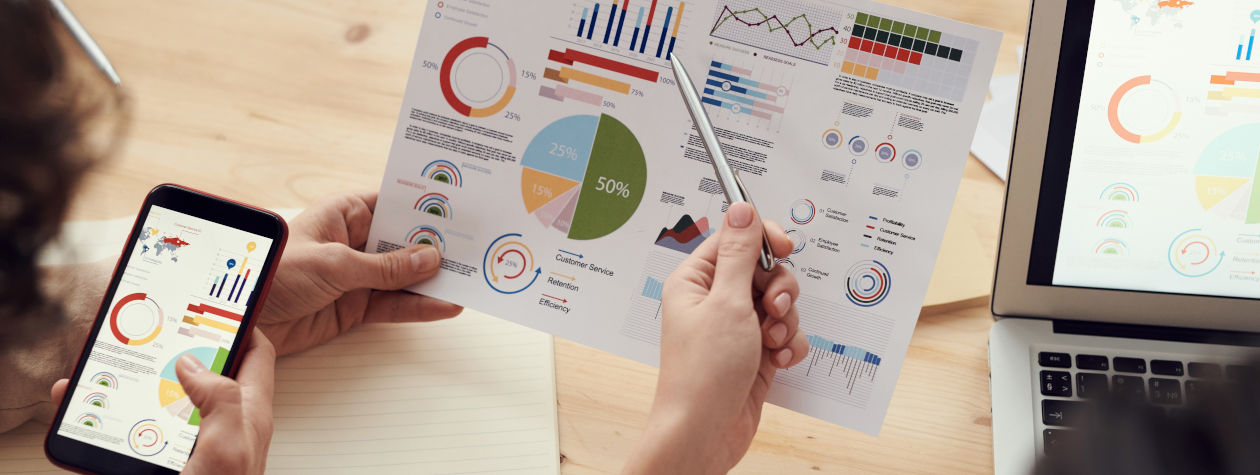We’ve previously talked about Key Performance Indicators (KPIs) and Benchmarks. Hopefully, you’re using them in your ecommerce business to track performance. Instead of picking between ecommerce benchmarks vs KPIs, you need both to ensure you’re moving toward your goals.
There’s a good reason why you need both. Before I get on to that, let’s recap what benchmarks and KPIs are and how to use them.
Ecommerce benchmarks are a way to compare performance, both internally (eg. last quarter or year) and externally (eg. competitors).
KPIs are a health check that helps you understand how your current performance aligns with your goals. They’re big picture but help you keep on track.
Again it’s not a choice between ecommerce benchmarks vs KPIs, you need both. They help build a picture of how your ecommerce business is performing over the short, medium, and long term and also within your wider industry.
Why Are Ecommerce Benchmarks Important?
Many founders focus on creating the future they want and don’t spend much time comparing their current performance with historic figures or against their industry in general.
This is a big mistake.
To best understand your progress or lack of it, you should look externally. I’m not saying your self-worth or that of your business is tied to the opinion of others. Simply that, using a mix of internal and external benchmarks helps you better understand your situation.
Let’s start by defining internal and external benchmarks, and then we’ll look at what benchmarks we can use.
Internal benchmarks are a comparison between this year’s figure and last’s year numbers.
External benchmarks involve comparing your business to another business, the industry, or the economy in general.
Common ecommerce benchmarks
If you don’t know, I’m a massive fan of keeping things simple. Rather than giving you a long list of fairly unhelpful benchmarks, I want to encourage you to use a few simple ones.
In terms of internal benchmarks you could use:
- Sales this quarter vs the last quarter
- Sales this quarter vs this quarter last year
- Average Order Value (AOV) this month vs last month
- Average Order Value (AOV) for summer sale vs last year’s summer sale
- Average time on site this week vs last week
Hopefully, you get the idea of some internal benchmarks you could use.
It’s also useful to have some external benchmarks, you could use:
- Your 6 months’ sales vs figures for your industry
- Your Net Promoter Score vs the industry average
- Your Customer Lifetime Value vs industry average
Using ecommerce benchmarks to improve your business
It’s easy to convince yourself that business is great. The numbers feel the same as last year. Your niche is growing or at least that’s what others are telling you.
However, unless you’re using data and benchmarks, you won’t have a clue as to whether your business is doing better, the same, or worse as the last period. You need to collect and analyze data. Please don’t rely on feelings!
The more meaningful data you have, the better you’ll understand how your performance stacks up against the industry and historically.

Are KPIs Also Required For Your Ecommerce Store?
If benchmarks describe the big picture, KPIs illustrate the internal goals in an easy to measure fashion. Yet they are still part of understanding the big picture.
I see KPIs as a health check. After waking up, you’ll ask yourself how you feel that day. You might feel great, ok, or bad. It takes a millisecond to answer. Your KPIs should be similar.
Aim to set 2 or 3 KPIs. Each should use data that are easy to find and helps describe the overall picture. You should be able to measure your KPIs with a yes we hit the number or no we didn’t. It should take you a few seconds to answer these 2 or 3 questions every morning.
Common KPIs for ecommerce stores
Again keeping it simple. You could set KPIs for daily revenue, number of orders, AOV, time on site, and more. But it’s essential you have a figure you’re trying to hit. For example:
- Daily revenue of $1,000
- Daily traffic of 2,000 visitors
- Average time on site of at least 3 minutes
- AOV of $100
- At least 10 orders per day
- First response to support tickets of under 1 hour
You get the idea.
KPIs you should use to track to improve business performance
You should set KPIs that are a little higher than your current performance, giving you something to aim for. But don’t go over the top and set yourself targets you can’t reach in a month of Sundays! Over time as you reach these figures consistently, you can increase them.
If you have a week or two of missing any of your KPIs, you’ll need to take a deeper look at the data and create a plan of how you’ll improve performance to hit your KPI consistently.

Ecommerce Benchmarks vs KPIs: Why you need both
Hopefully, you can see it’s not a case of needing either ecommerce benchmarks vs KPIs but that you should have both. Only having one will give you an incomplete picture and won’t allow you to make the best possible decisions.
The best starting point is to pick one of each. Get used to measuring your KPI daily and your benchmark monthly. After a few months, you can expand the amount of data points you track as you’ll have built up some good habits.
Need a partner who can design your rocket-fuel ecommerce growth strategies and supervise their execution?







